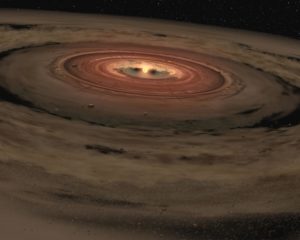The solar system formed when an enormous cloud of gas and dust began to collapse and rotate. As it spun faster and faster, it formed a disk which helped feed into forming the young sun in the center of it all. From this disk, small particles of dust started sticking together, and continued to grow into objects that were centimeters, then meters, and kilometers in size. Eventually some of these planetary embryos collided, resulting in even more massive, planet sized objects or sometimes satellite moons.
The characteristics that make up planet-forming disks in our solar system and in others has everything to do with the planets that are born out of it. But planet-forming disks continue to hold many mysteries about the process of planetary formation and how this process might translate to extrasolar systems across the galaxy. Uncovering the details of the process can also provide insights on how organic materials, the ingredients of life, were produced.
Measuring disk masses is an important first step in answering these questions and one of the key goals of the Earths in Other Solar Systems program, according to Josh Eisner, PhD., associate professor of astronomy at the University of Arizona.
Eisner and his team measured disk masses in the Orion region of the sky using the Atacama Large Millimeter Array (ALMA) to obtain high resolution images of disks in millimeter and submillimeter wavelengths. They were interested in this region because most stars in the galaxy, including the sun, probably formed in similar regions, Eisner said. What he was trying to understand is what disks were like in their initial conditions, which is before any planets start to form.
What was found was that low mass disks are common, according to his paper published in April. Creating gas giants like Jupiter requires a lot of mass, and as it turns out, very few disks (ranging from 2-20%) are massive enough to create a Jupiter-sized planet.
However, Jupiter-sized planets are relatively common and seem to form from disks when enough material is present, according to Joan Najita, PhD., astronomer at the National Optical Astronomy Observatories. So in order for giant planets to form, planetary formation seems to be more efficient than previously thought.
Another interesting characteristic of large disks is that scientists observe more rich organic materials in systems with larger disks, according to Najita.
Najita observed this by comparing the ratios of molecules containing carbon, such as hydrogen cyanide (HCN), with molecules containing oxygen, such as water in disks. What they found using the Spitzer Space Telescope was that systems with massive disks are more efficient at storing oxygen in the giant planet region further out. This prevents oxygen from locking up more carbon in the form of carbon monoxide, and instead leaves carbon available to be combined with other elements that create organic molecules, such as HCN. This and other chemical trends in disks are being followed up as part of the Earths in Other Solar Systems program.
The fact that this can be determined in disks means that the ingredients for life are created pretty early in solar system formation. Overall, planet-forming disks begin making planets earlier and more efficiently than we thought.
There’s still a lot of work to be done to confirm this. But “this is the next step and we’re working on it now,” Najita said. “And it’s correct so far!”

